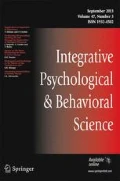Abstract
The accuracy of polygraphic lie detection in real life applications is very little better than chance. Yet, at least in the United States, many agencies and the polygraphers themselves have great faith in the technique. The reasons why polygraph examiners, and their clients, genuinely believe in the myth of the polygraph are explained and illustrated. A more plausible method of polygraphic interrogation, the Guilty Knowledge Test (GKT), is described and it is shown how the GKT, but not the lie test, might have resolved doubts about the case of Demjanjuk, the alleged “Ivan the Terrible.”
Similar content being viewed by others
References
Balloun, K.S. & Holmes, D.S. (1979). Effects of repeated examinations on the ability to detect guilt with a polygraphic examination: A laboratory experiment with a real crime.Journal of Applied Psychology, 64, 316–322.
Barland, G. & Raskin, D. (1976). Validity and reliability of polygraph examinations of criminal suspects. (Report 76-1, Contract 75 NI-99-0001). Washington, DC: U.S. Department of Justice.
Bradley, M.T. & Warfield, J.F. (1974). Innocence, information, and the guilty knowledge test in the detection of deception.Psychophysiology, 21, 683–689.
Cimerman, A. (1981). “They’ll let me go tomorrow”: The Fay case.Criminal Defense, 8, 7–10.
Davidson, P.O. (1968). Validity of the guilty-knowledge technique: The effects of motivation.Journal of Applied Psychology, 52, 62–65.
Giesen, M. & Rollison, M.A. (1980). Guilty knowledge versus innocent associations: Effects of trait anxiety and stimulus context on skin conductance.Journal of Research in Personality, 14, 1–11.
Horvath, F. (1977). The effect of selected variables on interpretation of polygraph records.Journal of Applied Psychology, 62, 127–136.
Iacono, W.G., Boisvenu, G.A., & Fleming, J.A. (1984). Effects of diazepam and methylphenidate on the electrodermal detection of guilty knowledge.Journal of Applied Psychology, 69, 289–299.
Iacono, W.G. & Patrick, C.J. (1987). What psychologists should know about lie detection. In A.K. Hess & I.B. Weiner (Eds.)Handbook of forensic psychology. New York: John Wiley.
Iacono, W.G. & Patrick, C.J. (1988). Polygraph techniques. In R. Rogers (Ed.),Clinical assessment of malingering and deception. New York: Guilford Press.
Kleinmuntz, B. & Szucko, J.J. (1984). A field study of the fallibility of polygraphic lie detection.Nature, 308, 449–450.
Lykken, D.T. (1959). The GSR in the detection of guilt.Journal of Applied Psychology, 43, 385–388.
Lykken, D.T. (1981a).A Tremor in the blood: Uses and abuses of the lie detector. New York: McGraw-Hill.
Lykken, D.T. (1981b). The law and the lie detector.Criminal Defense, 8, 19–27.
Lykken, D.T. (1988). The case against polygraphy. In A. Gale (Ed.).The polygraph test: Lies, truth, and science. London: Sage.
Lynch, M.B (1975). The American polygraph as the party affirming legal and social justice.Polygraph, 4, 154–164.
Murray, K.E. (1989). Movement recording chairs: A necessity?Polygraph, 18, 15–23.
Podlesny, J.A. & Raskin, D. (1978). Effectiveness of techniques and physiological measures in the detection of deception.Psychophysiology, 15, 344–359.
Reid, J.E. & Inbau, F.E. (1977).Truth and deception: The polygraph (“lie detector”) Technique, 2nd Ed. Baltimore: Williams & Wilkins.
Stern, R.M., Breen, J.P., Watanabi, T. & Perry, B.S. (1981). Effect of feedback of physiological information on responses to innocent associations and guilty knowledge.Journal of Applied Psychology, 66, 677–681.
Toronto Police (undated).Your Rights When Asked to Take a Polygraph Examination. Handout used by the Metropolitan Toronto Police Department during the 1980s.
Author information
Authors and Affiliations
Rights and permissions
About this article
Cite this article
Lykken, D.T. Why (some) Americans believe in the lie detector while others believe in the guilty knowledge test. Integr. psych. behav. 26, 214–222 (1991). https://doi.org/10.1007/BF02912513
Issue Date:
DOI: https://doi.org/10.1007/BF02912513



